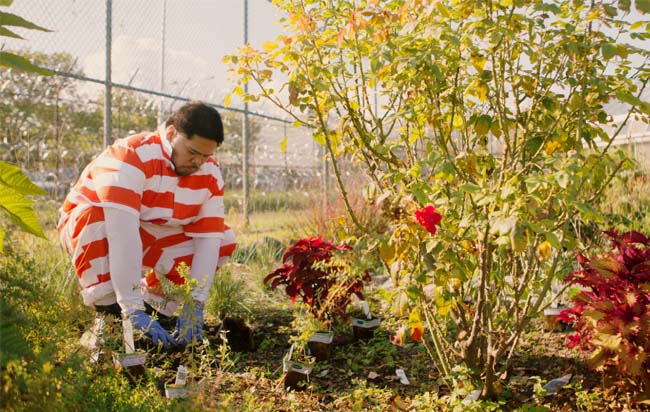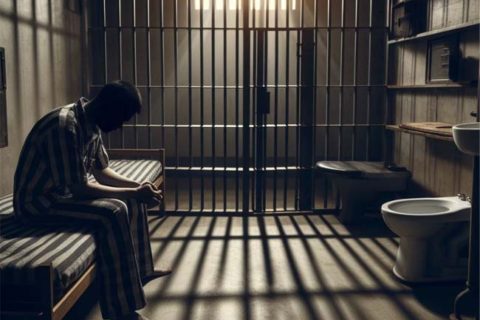Prison, in its operational content, is not just a place for people who have committed offenses to spend their sentences and remain behind bars. More broadly, prisons ideally become a means for them to improve their behavior, control their emotions, and also develop their interests, either discovering new skills or boosting the talents they already have.
Thinking prisons are only buildings with iron and sturdy walls is actually wrong. The vegetable and flower gardens behind the prisons are sometimes hidden gems. For inmates, the beauty of the prison garden really makes them speechless—a sight that cannot be ignored after spending a day in the cell.
To know more about the prison garden and what inmates do in the space, let’s discover it in our post below!
How Does Prison Garden Contribute to Inmates for a Living?

The beauty of the prison garden, for inmates at this facility, could be a meditative and healing space. Just looking at the garden and seeing something natural growing, they put their love and work into it.
Some studies showed that gardening programs actually work as low-cost prison programs that could be effective to run in prisons, in which inmates can obtain valuable foods to be consumed or donated to those in need.
The prison garden is such a beneficial space that can be used to grow various kinds of plants, such as flowers, vegetables, and fruit, as well as raise honeybees. The produce can meet the food supplies in the prison kitchen, so the facility can save money to provide the ingredients for cooking.
Inmates at Cook County Jail, Chicago, Illinois, take advantage of the prison garden to plant, grow, and harvest crops. Not only are the crops consumed by inmates, but they are also sold to high-end restaurants around Chicago. Of course, the profits will be used for prison operations and also for prison kitchen needs.
In Atlanta prison, particularly at a women’s prison facility, you may find a garden that is a quarter of an acre in size and actually produces plenty of tomatoes, blackberries, peppers, and more. What they produce in the prison’s garden is actually enough to feed the women growing the food as well as the nearby community.
At South Central Correctional Center in Missouri, colorful flowers, such as lavender and sunflowers, grow well as if to dispel the essence of being in a prison environment.
In 2012, Nourishing the Planet, a publication of the Worldwatch Institute, reported that the garden programs do not only help with rehabilitation for inmates; they actually save thousands of dollars for states and local governments to fund prison operations.
It was reported that one prison garden in Missouri produced very abundant crops with additional yields, worth 163 tons in 2013. And the profits were donated to food pantries, churches, shelters, nursing homes, and schools.
What Prison Garden Programs Have Been Implemented in Most U.S. Prisons?
Prisons across the United States actually have their own programs for inmates; the horticultural program is one of them. This program has been utilized for vocational and therapeutic purposes, providing physically and psychologically beneficial services for inmates.
Additionally, gardening programs may be a great tool to improve social bonding among inmates. To run this program, most prisons have partnered with local educators, planting experts, and environmental organizations that link environmental stewardship with job training and education.
Gardening techniques that are currently being developed, including in prison, are hydroponic gardening, green roofs, and vertical gardening. And these are designed to be urban gardens. So, gardening can now be done easily, even in narrow spaces.
According to a journal article written by Khatib and Krasny in 2015, some gardening programs that have been implemented in some prisons successfully reduce the recidivism rate and also lower the symptoms of mental illness and aggressive incidents.
The following are some selected gardening programs that have been applied in most prisons in the United States:
1. GreenHouse
Greenhouse is a gardening program that has been implemented at the Rikers Island Jail Complex in New York City, NY. This program was started in 1997 by the Horticulture Society of New York (HSNY). It actually provides work experience and horticulture training in design, installation, and garden maintenance to inmates.
Male and female inmates don’t work at the same time in the garden; they instead work in shifts. The garden at the Rikers Island Jail Complex has a series of lush beds and borders, including butterfly and bird gardens, a vegetable garden, a medieval herb garden, and a native woodland garden.
Inmates who graduate from GreenHouse will receive a certificate of completion and achievement, and they will be eligible to participate in the Horticulture Society of New York’s post-release program, called GreenTeam. Of course, they can pursue other job possibilities after they’re released from prison.
2. Insight Garden Program (IGP)
The founder of IGP, Beth Waitkus, emphasized that this gardening program aims to transform lives through connection and nature, ending the cycle of mass incarceration and creating safer, more connected communities both inside and outside prison walls. This program was started in 2003 at Solani and San Quentin State Prisons in California.
IGP actually teaches about the “inner” and “outer” gardeners, which means the lessons for inner gardeners focus on dealing with transformation and change, mediation, emotional processes, work, and eco-therapy. While outer gardeners will learn how to deal with human and ecological systems and organic vegetable and flower gardening,.
After inmates are released from prison, they can have opportunities to get vocational certification, employment skills, paid work experience, entrepreneurial training, job placement support, and access to legal services, housing aid, mental health, and substance abuse support.
3. Roots to Re-Entry
This gardening program, which is run by the Pennsylvania Horticultural Society (PHS), has been applied at the Philadelphia Prison System’s northeast complex. Inmates would participate in intensive training at the prison greenhouse and garden. What they can obtain in the garden will be donated to prison kitchens and food kitchens throughout Philadelphia.
After inmates have completed the six-week training program, they may receive job training and placement assistance in local food production or landscape management.
Okay, those are the three gardening programs that have been implemented in most prisons in the United States.
To make it easier for you to compare the performance of each gardening program, we’ll show the summary below!
|
Gardening Program |
Population | Measures |
Results |
| GreenHouse | Male and female inmates at Rikers Island State Prison, New York City, NY. | Recidivism rate and qualitative interviews | Recidivism:
After one year: 10% recidivism of graduates versus 21.5% of the general population of the prison. After 3 years: 25% for graduates versus 47% for the general population of the prison. Psychosocial: Inmates who have participated in this program revealed that they have greater happiness, sense of caring, and more inner calm. |
| Insight Garden Program | Adult male inmates at San Quentin State Prison, California | Recidivism rates | Of the 117 program participants released on parole from 2003-2009, less than 10% returned to prison compared with California’s average recidivism rate for the same period of 64%. This reduction in recidivism saved the state CA $40 million. |
| Roots to Re-entry | Adult male inmates at Philadelphia Prison Northeast Complex, PA | Number of job placements | Recidivism:
36 out of 42 inmates who participated in this program, have found jobs with local employers. |
What is the Basic Aim Behind the Prison Gardening Program?
Due to uncontrolled mental health problems in the United States prisons, most federal and state prisons, as well as county jails, have implemented horticulture programs, a.k.a. gardening programs, to help inmates manage their emotions.
It’s such an initiative for the prison program to conduct therapy for cognitive and emotional reform inmates. Until today, gardening programs have been one of the greatest things that are unique to most prisons in the United States.
We think that it’s really a great program that not only gives inmates real-life skills, but it also reduces their dynamic security risks by letting inmates relax and not cause trouble for the prison’s staff.
There’s no doubt that gardening has proven psychological and neurological benefits that can reduce stress and calm nerves. It also decreases cortisol, a hormone that plays a role in stress response. Many inmates consider the garden to be a place of meditation or therapy.
Nelson Mandela, an inmate at a prison (that isn’t mentioned), revealed that gardening was one of the great things that we could find in prison and work with. For her, the garden was not a place to plant a seed, watch it grow, care for it, and harvest it; it offered more than that. It really offered simple but long-lasting satisfaction—the feeling of being the guardian of the small patch of earth.

A bookworm and researcher especially related to law and citizenship education. I spend time every day in front of the internet and the campus library.




